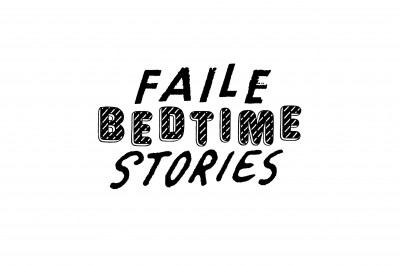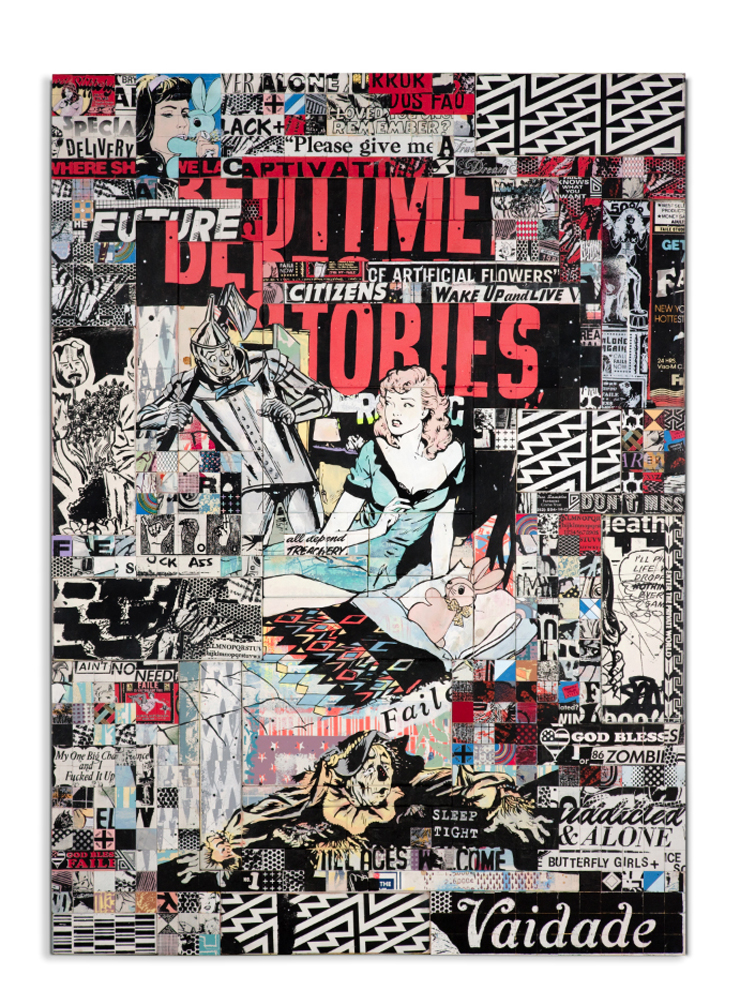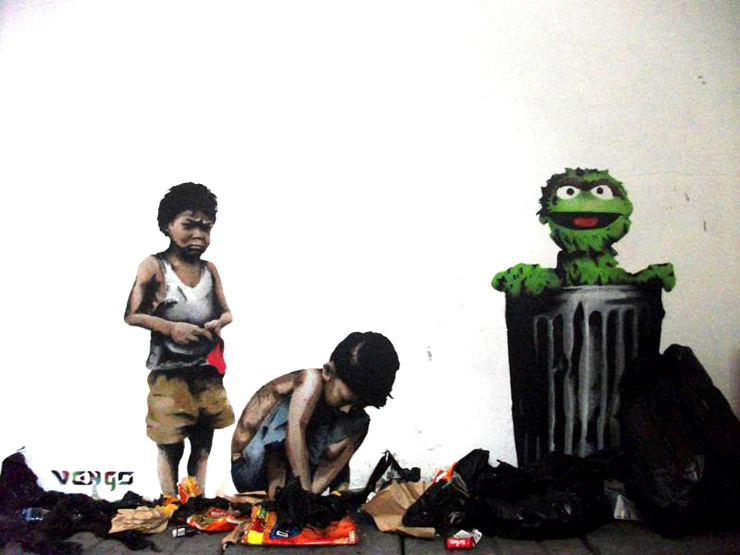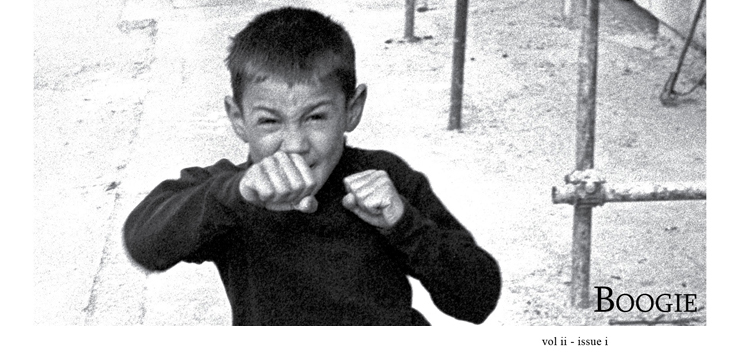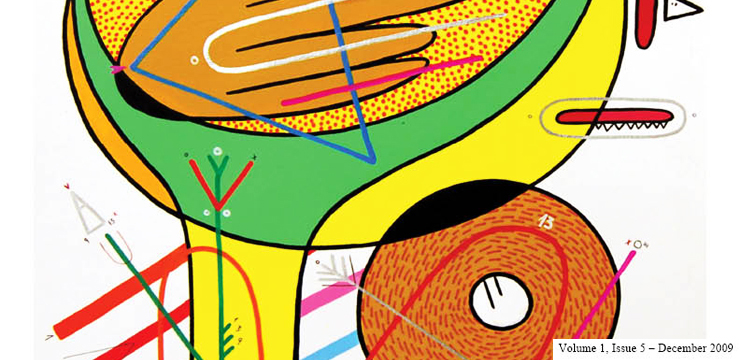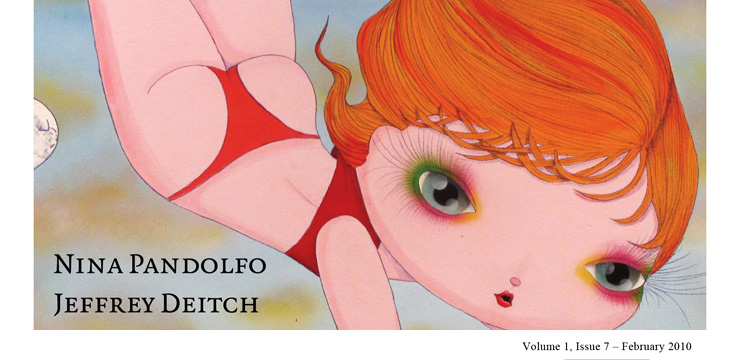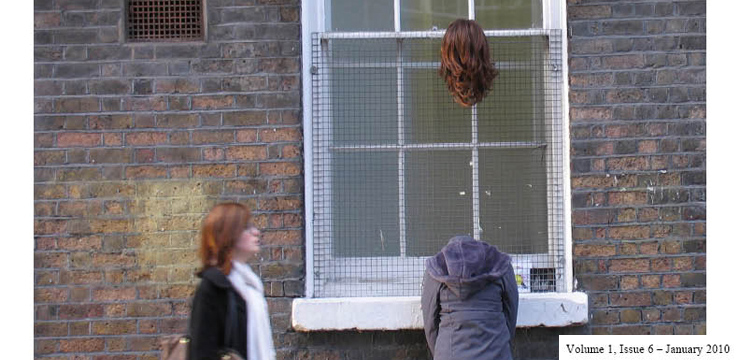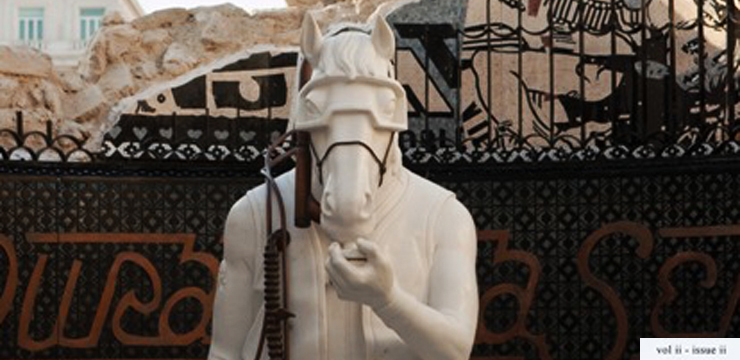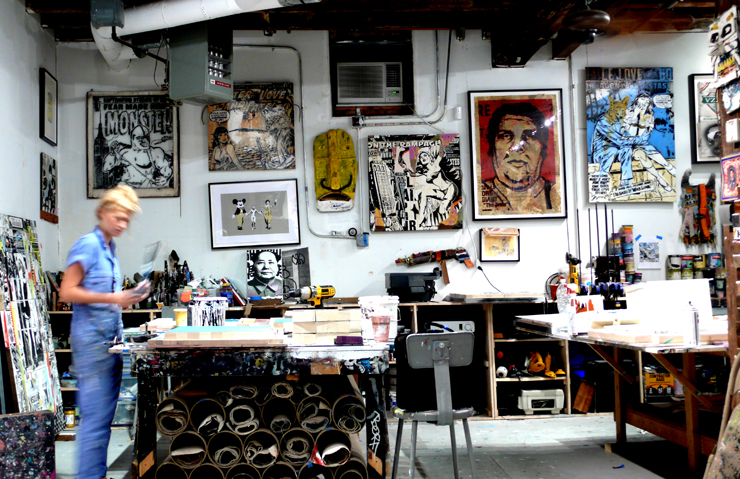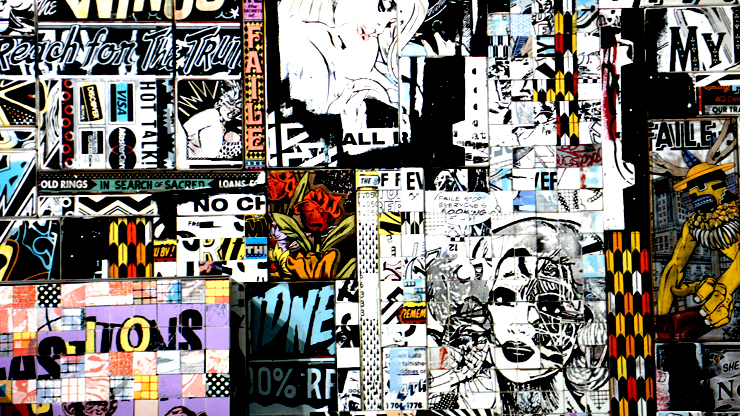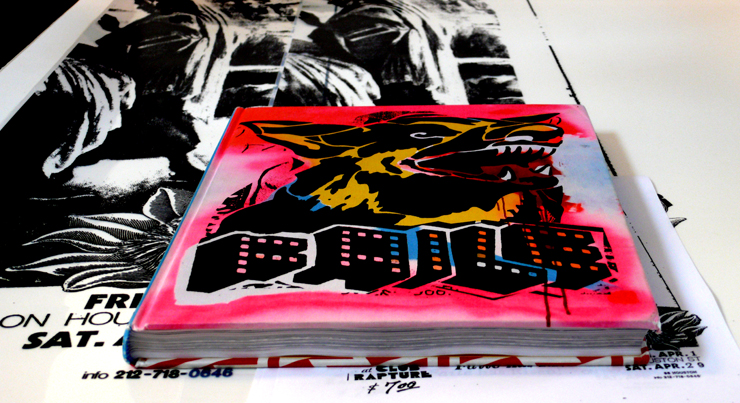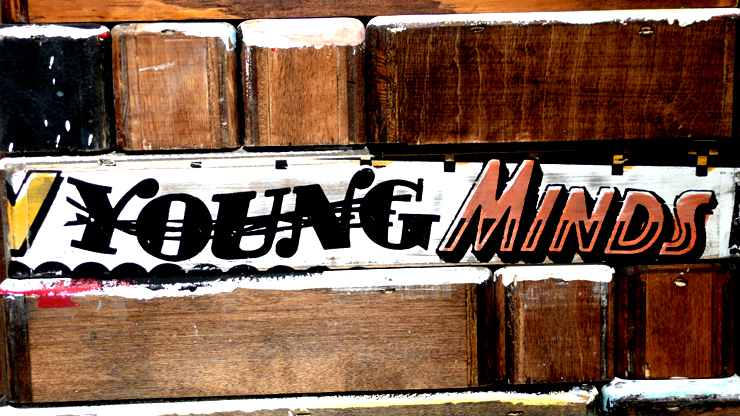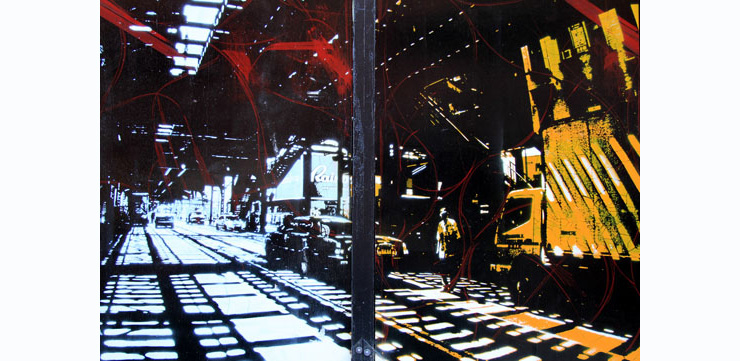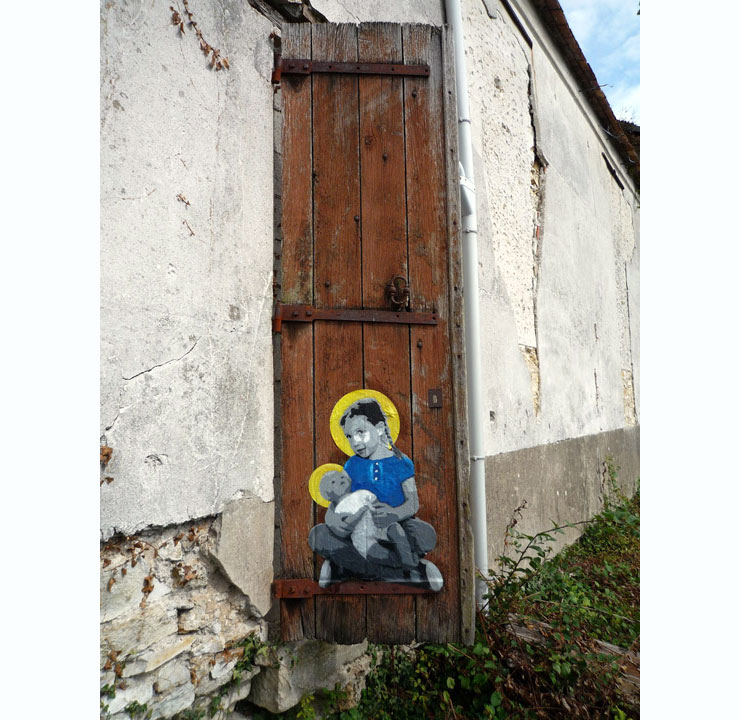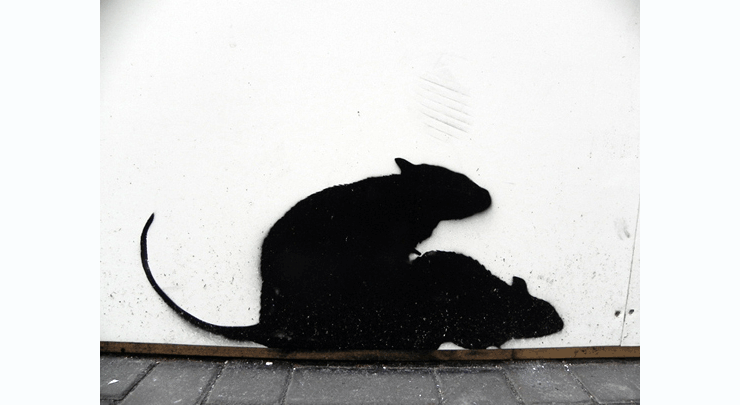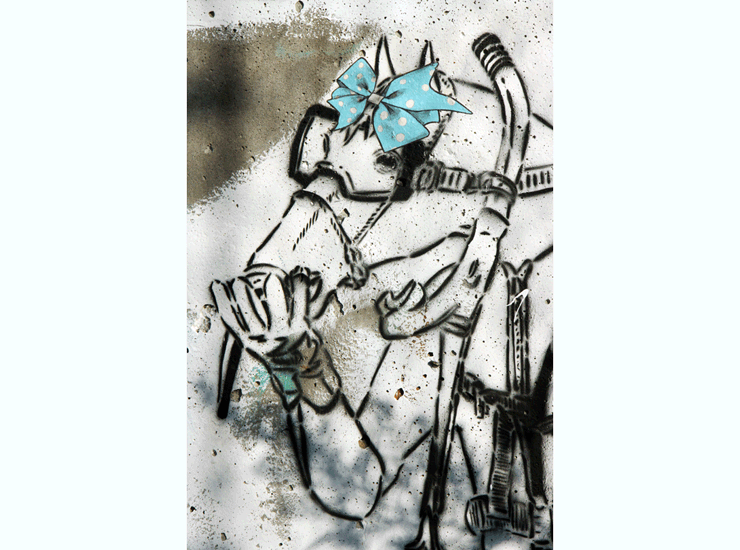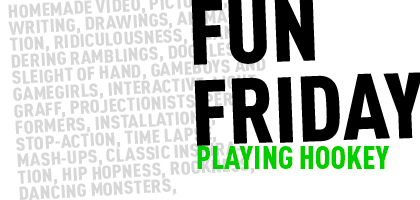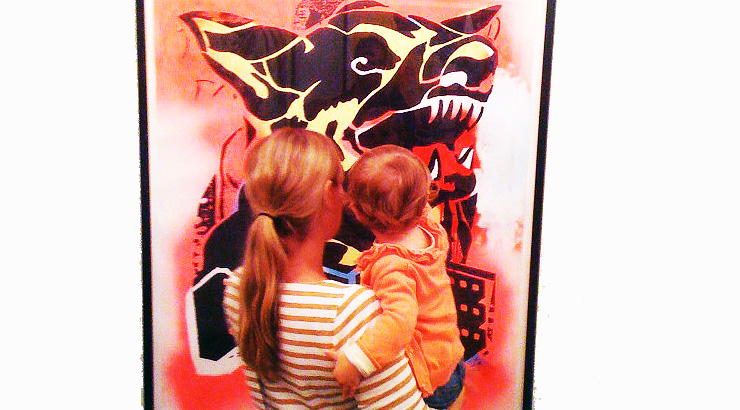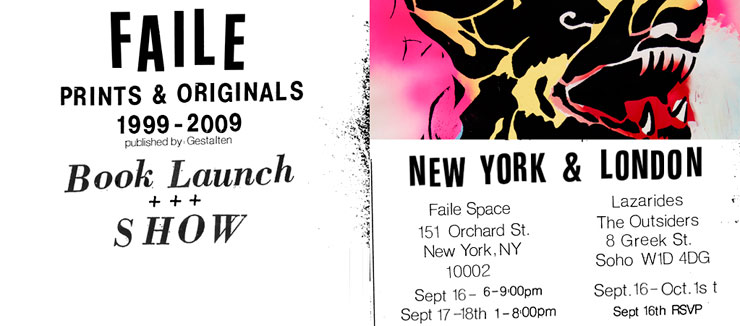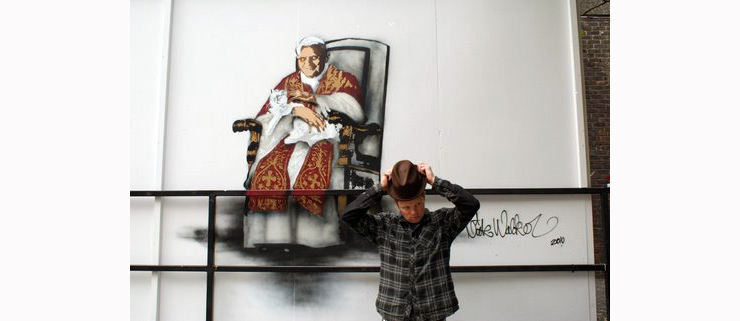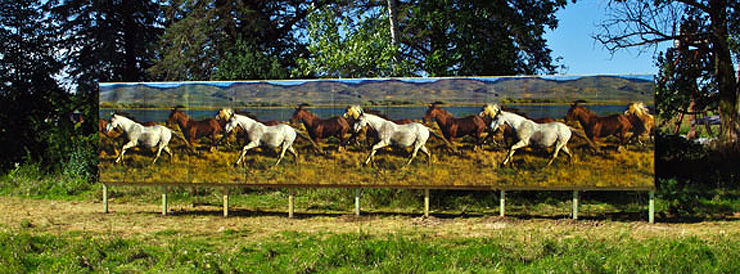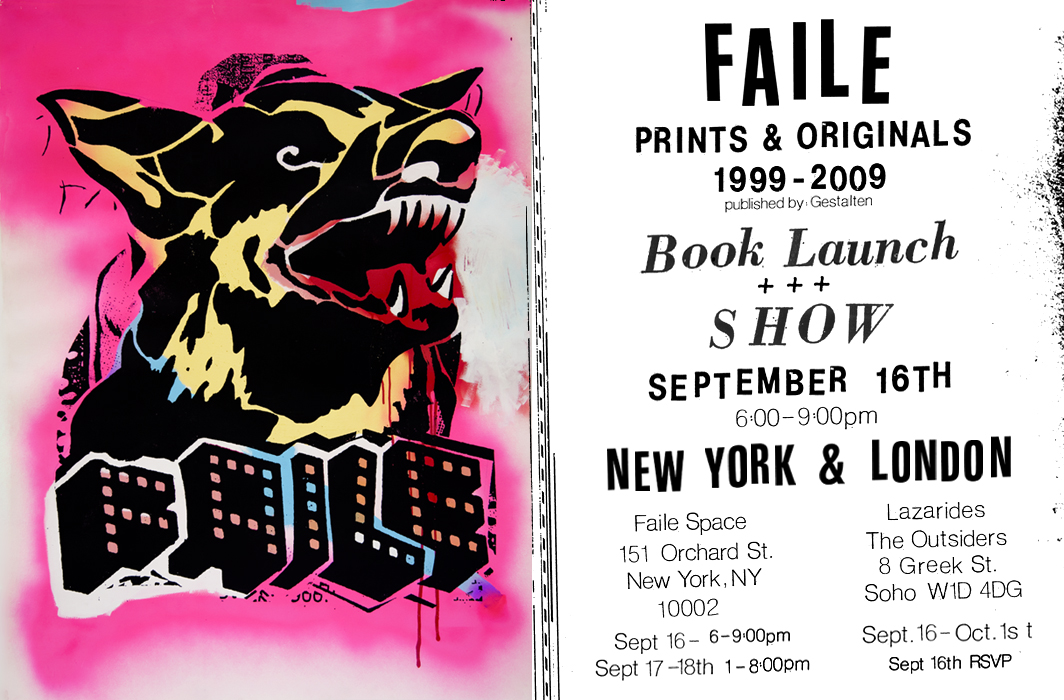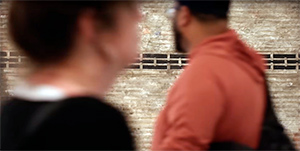Our Weekly Interview with the street, this week featuring Chelsea Girl, ECB, Faile, Frog, Radical!, REVS, Think Fly, and Tono
All posts tagged: Faile
Ready for Bedtime? Faile Tells the Story Tonight
“It’s not a typical show for us where it is like a huge thematic production. It’s a much smaller intimate show,” says Faile’s Patrick McNeil.
Faile partner Patrick Miller strikes a satisfied note, “It’s good, I feel confident about the work. I feel confident within about where we’re at within a given time. You can always go and tinker and keep playing but I’m happy with the body of work.”
Photo © Jaime Rojo
Okay, so sometimes we get too excited. Not by spectacle, or hype, or insider clubbiness – but by the art. Somehow Faile made this painted wood show feel electric.With fragments of images, snippets of phrases out of context, flashes of celebrity, skin, and irony, “Bedtime Stories” is an apt analogy for a lucid dream state, big city life, and our current fascination with glowing digital rectangles of all sizes.
The white box gallery isn’t always suitable for Street Artists; The raw energy of the street can feel stale when trapped inside and shows like this sometimes merit criticism from those who want to “keep it real”. But in typical Faile fashion, “Bedtime Stories”, opening tonight at Perry Rubenstein Gallery in Chelsea, is a considered, well presented multimedia manifestation that energizes the space. The one sculpture, a tree-trunk of titillation in the center of the chamber, serves as a jagged graphic lightening rod for the flashing neon particles that swirl around the space.
Faile Tells You “Bedtime Stories”
The first New York gallery show in three years for Street Art collective Faile opens tomorrow at Rubenstein Gallery; a heavy graphic quilt of past, present, and “jimmer-jam”. With the 12-piece “Bedtime Stories”, Patrick and Patrick debut a densely packed wood painting show of story, texture and humor in a quite intimate setting.
All Hands on Blocks
Checking on progress as they finished final pieces last week, Brooklyn Street Art was treated to completed block tapestries and works in progress in their buoyantly buzzing studio. Long days have turned to long nights at the end of this parsing of pieces, and the output exceeds the storage.
It’s a hard charging exploration of process, with the selective re-combining of broken-apart wood canvasses.
“Bedtime Stories” is a glut of hand-packed eye candy; steel girded graphic thoughts crashing and merging deep into the diamond mine of Faile’s visual verbiage, delivered with storytelling finesse. Each individual piece is a near-dizzying puzzle of pop plied with rigor chock-a-block against the restraints of an unbending welded frame.
Brooklyn Street Art: These new pieces feel very dense.
Patrick McNeil: It’s like eating chocolate cake with chocolate ice cream and chocolate pudding and a cup of hot chocolate. They are a lot to take in.
Patrick Miller: They need space.
As they talk you get the idea that they needed some psychological space from the constrictions of a themed show and they became enamored with the wood painting process more than the exact outcome. It’s clear that the new approach has been gratifying.
Patrick McNeil: This isn’t really an exhibition about message, it’s more about process. Not to say that it is devoid of any message. It’s just been more about building than about going out and trying to make a statement with the visual.
Patrick Miller: Yeah I think that’s more what we talked about a little before – about how it was about getting loose and have fun making images again and not feeling like it was one big overarching theme that was going to drive the whole body of work. Given that we were really interested in exploring the medium, I think the message is kind of coming through in the process.
Patrick McNeil: Yeah I think our last two shows were so theme related that I was like, “Let’s not think about the space as much.’ It’s more like, let’s just make a body of work and when it’s show time let’s collect it all and see what hangs right and looks good in the show and go about it that way. We wanted to be more organic in the process instead of so structural.
Patrick Miller: Some of our recent previous shows were “a series of” paintings that either ran together or lived together in some way –although these actually do too in a way.
Brooklyn Street Art: Well each piece contains your DNA so they kind of have to reflect your story.
Patrick Miller: Right, they all start as a bigger piece, and then those get broken apart and built back into other pieces. I feel like when you look at them all and they are all spread out you can really see; “Oh, that’s a part of that, and this is a part of that”. So in that way I feel like it is a “Faile” kind of thing.
In the middle of the studio a large wooden canvas painted blue with a black lined pulp inspired tryst is lifted by three studio assistants to rest on blocks against the wall so that it’s bottom can be painted. Later this thick wooden canvas will be sawed into cubes, but for now it is a complete 4’ x 6’ duotone.
The process of creating can encompass many pieces developing at once. A smaller or midsize piece that grows beyond its’ original boundaries is re-located into a larger frame where it has more freedom to grow.
“We don’t want to see any go out without enough lovin’, ya know”
Often a piece will get re-worked multiple times to finally strike the balance that it needs – a intuitive sense that both Patricks have and trust in the other. Studio assistants have also learned the language of Faile and can tell when something probably needs reworking.
Patrick McNeil: There’s a lot of made up words; Shimmer-sham, Jimmer-jam….
Brooklyn Street Art: Shimmer-sham? Jimmer-jam?
Patrick McNeil: Yeah you’ll be like, “That needs a little shimmer-sham right there and some down there.”
Brooklyn Street Art: And does shimmer-sham mean the same thing, have the same definition for everybody?
Patrick McNeil: Yeah, pretty much.
Patrick Miller: Pretty much.
Ask the studio assistants, and they’ll tell you the same; In a close-knit group that works long hours together making art, it’s not unusual to develop a vocabulary and shorthand that speaks to the art and the process.
Brooklyn Street Art (to studio assistant Sarah): If one of the Patricks said, ‘we need more Jimjam over here’…
Sarah: Jimmer-Jam (laughter)
Brooklyn Street Art: What would that mean?
Sarah: Um, it really depends on the context I would say.
Patrick McNeil: And the gesturing involved.
Sarah: And the gesturing, yeah
Brooklyn Street Art: So if the gesturing is very insistent, then it might mean…
Sarah: It usually is in reference to something that’s already happening. If it needs more of something or less of something. Also Zibber-zabs.
Brooklyn Street Art: Zibber-zabs? Which is analogous to
Patrick Miller: Which is very different! You could have a problem..
Brooklyn Street Art: Are there other vocabulary words?
Sarah: Um, those are the two that are most frequently used. Jimmer-jams and Zimmer-zabs. (to the others) Can you guys think of anymore?
Maggie: Did you say Shim Shams?
Male assistant: “Could use a little more lovin’ ”
Sarah: Yeah, that’s a P. Miller one.
Brooklyn Street Art: What would ” lovin’ ” mean in this context?
Patrick Miller: It’s like ‘you need to push it a little more’
Brooklyn Street Art: More attention?
Patrick Miller: Yeah. We don’t want to see any go out without enough lovin’, ya know
It’s not likely that would ever happen in a Faile show, they care too much. A loose tension. Structure and play. The rebel yell. Details don’t slip by, meanings are hardly incidental, and everything is considered. Smartly aware of concepts like brand and marketing, they stay on message and deliver the goods. New patterns and texts must be vetted and go through a background check. Just kidding.
“Block Shock”
Brooklyn Street Art: What is “Bedtime Stories”? – A reference to your parents, your mates, your children, Madonna, Peter Rabbit?
Patrick Miller: I think we’d been searching for a title. We’d been talking about different things along the way. One of the pieces in the show is called “Bedtime Stories” and it’s a part of one of the new images. I think one thing we kept thinking about was that there was a period when we were both really interested in quilt making. We did a lot of research on it.
Brooklyn Street Art: Quilt making?
Miller: Yeah, and we kept saying throughout this process to each other how quilt-like these wood paintings were to us in a way. How much the process reminded us of that kind of craft feeling; Old American quilt making and that tradition. There was something about that – and bedtime, and beds. And then “Bedtime Stories” obviously refers to the narrative quality of the pieces and there is so much of that built in. As they come together and we take bits out of one thing and put it into another thing it starts to make new stories. There is sort of this tension between the pieces and how much visual experience that is in all of them and the bedtime being this quiet special moment. All those things, for me, made me feel like bedtime stories was a good fitting title.
Brooklyn Street Art: (to McNeil) You didn’t have anything to add to that?
Patrick McNeil: That’s pretty much it.
Patrick Miller: It won out over “Block Shock”! (laughing)
Brooklyn Street Art: Yeah, that name has a certain alliterative quality right?
Patrick McNeil: It really is shocking through blocks. They are kind of shocking pieces in the sense of the denseness of them and how much is in them.
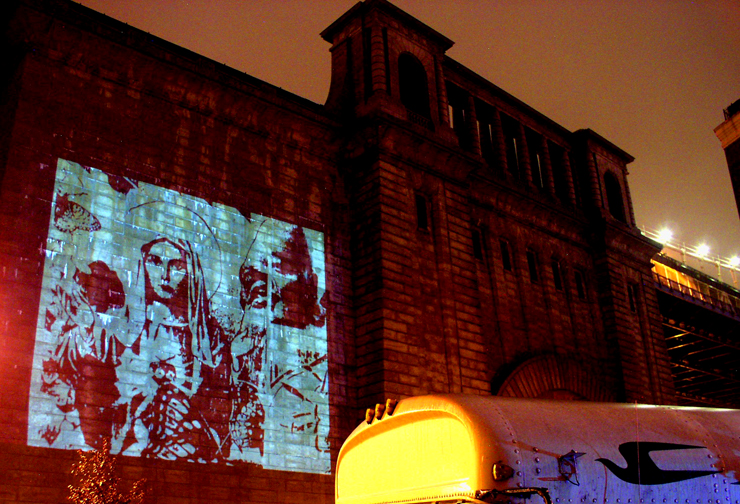
BSA’s “Projekt Projektor” in Dumbo, Brooklyn as part of Under the Bridge Festival September 2008. Image of Mary by Faile ( photo © by Jaime Rojo )
Brooklyn Street Art: In a way these pieces are also analogous with dream states and what you remember the following day.
Patrick Miller: It’s true.
Brooklyn Street Art: They could be very intense pieces but…
Patrick Miller: And dreams, like, your memories of them are so fragmented. You are kind of left with “I remember this part and that part”, and that’s how these pieces are. They are assembled parts that make up this kind of weird tapestry.
Brooklyn Street Art: Right, and the parts of the dream that you remember are the most vivid, emotionally charged ones, or psychologically charged parts, not the subtle parts.
Patrick Miller: Yeah, and that’s a great way of seeing it.
Brooklyn Street Art: And you guys are not really marketing subtlety
Patrick Miller: No, not in this show.
All Photos © Jaime Rojo
BSA………………………BSA……………………. BSA………………………BSA…………………….
FAILE
Bedtime Stories
Perry Rubenstein Gallery
November 4th – December 23rd, 2010
Street Art And The Day Of The Dead
“Dia de los Muertos”
Skulls are everywhere on the street today, and here is a collection to mark The Day of the Dead. The commemoration of people who have passed is observed nation-wide in Mexico every year at this time. Although it is not a national holiday, the strictly religious and cultural observance is revered and, depending on the region, it varies in the ways in which the holiday is marked.
The cultural aspect of this holiday has inspired many artists, filmmakers and poets. Here we have selected images of Street Art culled from our library to mark the Dia de Los Muertos, focusing on the most prominent symbol used to represent this holiday: “Las Calaveras” or skulls.
Mexico’s “Dia de los Muertos” or “Day of the Dead” takes place every year on November 2 to coincide with the catholic holiday of “El Dia de los Santos” or “All Saints Day”. The Day of the Dead is not the Mexican equivalent of Halloween. The Day of the Dead in Mexico is a celebration of Death and it does not carry any of the connotations of fear, fantasy and gore that Halloween does.
This religious and cultural holiday can be traced as long ago as 3000 years. Before the conquest of what’s now modern Mexico in the pre-Hispanic era the indigenous cultures celebrated death, rebirth and their ancestors by displaying human skulls as memento mori.
When the Spanish missionaries arrived more than 500 years ago they tried without success to eradicate such pagan and sacrilegious celebrations that seem to mock death while converting the indigenous people to Christianity. To the Spaniards death was the end of life but to the Aztecs it was a continuation of a journey not yet completed. The Aztecs embraced death and they celebrated it for the entire month of August, the ninth month of the Aztec Calendar, and the festivities were presided by the goddess Mictecacihuatl or “Lady of the Dead” presumed to have died at birth.
The Spaniards were met with fierce resistance in their attempts to vanish the rituals so in frustration they sought and found a common ground with the natives by moving the pagan rituals to coincide with the Catholic holiday of “El Dia de los Santos” or “All Saints Day” on November 2.
Modern Mexicans remember their friends and family members that have departed from life by honoring them with extravagant festivities that, depending in the region might include lavish offerings or “ofrendas” in private altars in the cemeteries at the tombs of their loved ones and/or at home. It is a day of celebration and many people elect to stay overnight at the cemetery for prayer, and remembrance but partying, eating and drinking is encouraged and expected always following the norms of respect and decorum for the defunct.
These “ofrendas” or gifts include the most favored dishes, foods and beverages that their loved ones enjoyed while alive. They also include photos and other personal mementos of the deceased ones. The “ofrendas” are meant to be eaten and shared by the relatives and friends of the departed and sometimes they are very elaborate five course dinners. Other times the relatives might choose to have a daytime picnic at the cemetery and return to their homes at dusk. The “ofrendas” are believed to nurture and help the souls of the dead while in their journey to heaven.
Some people use this day to just take their customary once a year trip to the cemetery to clean and maintain the tomb of their loved ones.
Regardless of the singular cultural distinction of each region two symbols are common throughout the country: “La Calavera” or The Sugar Skull and “La Catrina” or The Skeleton Lady. The Skulls can be made of sugar and chocolate and often are inscribed with the recipient’s names and are gifts to both the living and the dead. There is also “El Pan de Muertos” or “Bread of the Dead” which Mexicans give as gifts to the visiting relatives for their journey back home.
It is said that Mexicans not only celebrate death they also eat it.
Main Banner image credit: Jose Guadalupe Posada “Gran Calavera Eléctrica” Courtesy Library of Congress.
Perry Rubenstein Gallery Presents: Faile “Bed Time Stories” (Manhattan, NY)
FAILE
BEDTIME STORIES
November 4 – December 23, 2010
Perry Rubenstein Gallery
527 West 23rd Street
New York, NY 10011
T 212.627.8000
F 212.627.6336
info@perryrubenstein.com
www.perryrubenstein.com
November 4 – December 23, 2010
Opening Reception, November 4, 2010, 6:00 PM – 8:00 PM
New York, October 18, 2010 – Perry Rubenstein Gallery presents Brooklyn-based multimedia artists FAILE. The artist collaborative returns on November 4th with Bedtime Stories, an exhibition of new works that feature imagery mined from FAILE’s singular visual archive and that emphasize the painterly dimensions of their frenetic visual tapestries.
Following on the heels of two major projects—the interactive arcade of Deluxx Fluxx and the haunting, allegorical suite, Lost in Glimmering Shadows—Bedtime Stories is a return to fundamentals that pushes questions of form and process to the forefront. Each of the twelve works’ compositions are assembled from numerous painted wooden blocks and they emerge as unified paintings. They reveal FAILE’s relentless assimilation and refinement of the vast visual vocabularies of both the urban environment and their own decade-long practice. The grids of these paintings are at once modular and fixed, tactile and graphic. On their surfaces, iconoclastic characters fluidly intermingle with adroit deconstructions of commodity culture. The re-combinations of carefully constructed texts and images provide a glimpse into FAILE’s rigorous and organic process, and draw attention to painting’s inherent materiality.
Works such as Addicted & Alone and Faile Launch reshape painterly traditions of pointillism and the affichistes, while simultaneously suggesting newer media that draws on the pixelation of digital technology and the improvisational roots of collage and street art. Bedtime Stories presents works of a neo-baroque ilk yet they are aggressively beautiful while underscoring FAILE’s continued exploration of formal and aesthetic inquiry and evolution.
Perry Rubenstein Gallery
527 West 23 Street
New York, NY 10011
T 212.627.8000
F 212.627.6336
E info@perryrubenstein.com
W www.perryrubenstein.com
Gallery Hours: Tuesday – Saturday, 10:00 AM to 6:00 PM
Images Of The Week 10.10.10
This week, K-Guy primates appeared in the urban jungle of NYC while Vango, in Kiellarny, Ireland touched on American pop culture and Brooklyn’s own Faile gifted NYC with an amazing Prayer Wheel.
Print Is Dead, Long Live the Print Journal! Elisa Carmichael’s Passion
Detail of a photograph by Boogie on the cover of The Art Street Journal
Print publishing has been a heavyweight boxer on the mat with both shoulders pinned down for the last 7, 8, 9, 10 years. The multitude of problems that plague the publishing industry these days are rapid-fire punches: The down-shift economy, ad dollars swinging for social media, the high cost of print, and changing consumer behavior all sing the coda of the paper page. A recent survey published in Oriella Digital Journalism found that more than half of journalists surveyed think that their printed journals will eventually be knocked out cold by online.
Given this current climate, how can you dream of publishing a new free art magazine? Even the most entrepreneurial art fans would be discouraged, but Seth and Elisa Carmichael are no strangers to obstacles and their project, The Art Street Journal, is now in it’s second successful year.
Their L.A. gallery ‘Carmichael Gallery for Contemporary Art’ had already been in business for about a year when they were hit by personal trouble. The new bride Elisa, a British citizen and an Australian resident, had to leave the continental USA to tend to some very important and grievous family affairs back home. Compounding her hardship, Elisa discovered her return to The United States was barred due to visa technicalities. A prolonged calvary of Kafkaesque events ensued before she was able to re-unite with her young husband in California. It was during this time they began planning a newspaper about the thing they both love most: art.
Elisa and Seth are avid supporters of contemporary, street and urban art and believe that art must play a significant place in human development. Elisa’s new idea of editing and publishing a journal would focus on celebrating and supporting the arts and the community involved in its creation.
Detail of a piece by Sixeart on the cover of The Art Street Journal
We wanted to know what motivates Elisa to continue with her almost quixotic path to publishing and distributing a free print journal when many well-established and respected journals are folding by the dozen.
Brooklyn Street Art: Why are you and Seth publishing a printed journal when most publications in print are struggling to survive? What keeps you motivated to continue to publish it?
Elisa Carmichael: We have always wanted to have a magazine – it’s something we’d talked about doing for a long time. We enjoy blogs and considered starting one of our own, but decided in the end that we’d rather do something a bit different.
We have a shared love of books and magazines that goes back long before we met and believe that nothing can replace the magic of print. The Art Street Journal (TASJ) has given us a unique opportunity to support the artists and events that interest us in a medium we want to help keep alive.
We’ve received so many kind notes and words of encouragement from readers all over the world in the past year. It means so much to us that people enjoy TASJ. Connecting to a broad network of international art lovers has been a key motivator in keeping us going.
Aside from the enjoyment we derive from putting each issue together, our motivation comes from the positive response and rapid growth of our readership. It has been really interesting to monitor: Even though TASJ is a free publication, we really weren’t sure anyone would be interested in it. We have some great supporters out there – galleries, museums, clothing stores, cafes, specialty bookstores and individuals doing drop-offs at various locations in their cities around the world.
Detail of a piece by Nina Pandolfo on the cover of The Art Street Journal
Brooklyn Street Art: The journal’s main focus is in Street and Urban art. What drove you to this art genre in the first place?
Elisa Carmichael: TASJ certainly supports street and urban art, but its focus is really contemporary art as a whole. You will see many artists featured on our pages who have a street background because we love the energy inherent in Street Art. It’s an art form we are both very passionate about and believe has an important place in art history.
That said, TASJ is not a Street/Urban art magazine. Our aim is to curate content that combines the best art from the underground, emerging, and mainstream established worlds. The journal has an aesthetic through-line that links the artists we cover, regardless of their background, and I think that comes across when turning its pages. We also try to keep the editorial diverse and internationally focused, as well as give time to people and events that haven’t had too much coverage from other media outlets.
Detail of a piece by Street Artist Mark Jenkins on the cover of The Art Street Journal
Brooklyn Street Art: What’s your ultimate goal with TASJ?
Elisa Carmichael: There’s a place for all sorts of publications in the marketplace, but for us, the number one goal is to get the message out about the art we love to as many people as possible. We don’t believe that every nice independent art magazine needs to cost $20; there should be something out there that everyone can have access to. TASJ will always remain free.
We have a lot of different plans and goals —TASJ has quickly become a far bigger project than we originally envisioned and at this point it is really our second business. At the same time, we’re trying to let it develop organically and improve it a bit each time we bring an issue out. In one year our 4 page black and white newspaper is a full color magazine-style periodical.
Another goal we have is to show our art world associates that it’s possible for gallerists to want to support other galleries and artists, even when there is no personal or financial relationship. There is far too much cattiness and rivalry in the art world as it is without our contributing to it. We know how hard it is to stay alive and make things happen in this business and we respect the people out there who are doing just that. We like the fact that we’ve been able to build a little platform from which to celebrate those people and not ask for anything in return.
Detail of a piece by Faile on the cover of The Art Street Journal

Faile Studio Visit: Readying for Rubenstein
A visit with Street Art collective Faile in their Brooklyn studio finds the industrious duo at the center of a small cluster of assistants working on many projects simultaneously.
The air of collaboration is evident in this maze of activity – as well as an appreciation for process. The multi-level ex-industrial building has been reconfigured internally over the last decade to contain and accommodate the adventurous appetites of the childhood buddies who took their Street Art from Brooklyn to the Tate, with many stops along the way.
This doesn’t happen for everybody, so in this first visit of two before their upcoming debut solo show at Perry Rubenstein Gallery on November 4, we looked for clues about the creative and working DNA of Faile. In the ten quick long rotten beautiful years of this century they’ve plowed through many experiments methodically from simple one color small stencils on light posts to now museum quality raft-sized wooden block collages that take months to screenprint, saw, sand, and assemble.
One of Faile’s first street pieces from the late 90’s in Williamsburg, Brooklyn. (Photo © Jaime Rojo)
In a pretty remarkable run through the neighborhood and the globe the two Patricks have used aerosoled stencils, screen prints, wheat pastes, roller tags, animated video games, carved wood, vinyl sculptures, spinning prayer poles, even alabaster and tile reliefs in their ever growing collection of work. Cumulatively, the forays have given depth and resilience to their nearly iconic pop imagery.
Since returning from their Lisbon temple installation mid summer, where their piece (two years in the making) became a focal point for that city’s first biennial, the Faile dudes are now making a multitude of these “wood paintings” here in their Brooklyn studio. Among the many silkscreens stacked against walls, rolled canvasses in tubes, and pieces by Banksy and Shepard Fairey adorning the walls, there are open wooden boxes, maybe 20 or 30, full of small wooden printed blocks laying open on tables and shelves.
Brooklyn Street Art: When the blocks get that small they are almost just a texture.
Patrick McNeil: Exactly, or just color palette. It’s so modular you don’t get stuck with anything, you get to explore a lot and if it doesn’t work you just put it back the way that it was or pull it apart.
Brooklyn Street Art: That’s right, you can reverse yourself pretty easily
Patrick McNeil: Yeah you just kind of build a piece and then realize it works better in something bigger – so they are very loose in a sense. It seems very precision-y and thought out but it’s much more looser than it looks.
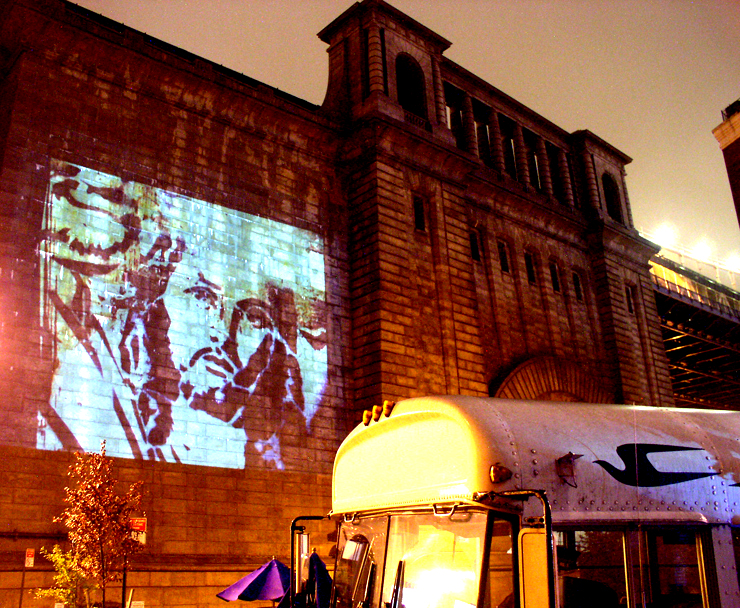
Faile’s Jesus appears on the side of the Manhattan Bridge during Brooklyn Street Art’s “Projekt Projektor” show in Brooklyn during the DUMBO Arts Festival in 2008 (Photo © Jaime Rojo)
The selective sampling of images that create the Lingua Faile has steadily grown into a library of totems, symbols, pulp art snippets, typefaces and signifiers set free from their context and recombined with a lucid dexterity, a splash of irony, and an inner voice that says, ‘go for it’. It’s an old-skool visual sampling that doesn’t need autotune for anything, just a hyped sense for combining clips and dropping it on the beat. Talking to them, one sees that it’s a loose intuitive sense that is guiding the process.
Patrick McNeil: And I like what is happening in this one, it’s still coming along. That one, the bottom needs to be worked out. It’s really top heavy. And we’ll kind of pull some colors down. That one is just kind of getting started. This one’s kind of in the middle right now; Just slowly working on blacks and switching things up.
Brooklyn Street Art: So you’ve used a lot of powdered pastels…
Patrick McNeil: Yeah…
Brooklyn Street Art: let’s see, blasting fluorescents…
Patrick McNeil: Well a little bit, yeah. There are not too many fluorescents, well, that pink is probably the only fluorescent. Well, there’s yellow on that one. But none of these have any fluorescent.
Brooklyn Street Art: I’m thinking of the DeLuxx Flux thing you did with Bast.
Patrick McNeil: Yeah Perry made the rule, “no fluorescents”.
Brooklyn Street Art: Oh okay. Well it’s good to have that guidance.
Patrick McNeil: Yeah, we might sneak one in there.
Patrick McNeil: Then we were looking more at abstractions, breaking color groups up, pushing it really far.
Brooklyn Street Art: Yes that’s an unusual combination of the violet and the grey. It looks fresh.
Patrick McNeil: Yeah, it’s kinda switchin’ it up. We kind of like tweak things and leave them up for a while and then switch it out. It’s kind of interesting.
Even though the new book, their first, is coming out to mark the first 10 years that took them from Brooklyn streets to group shows, street art exhibitions, galleries, and museums around the globe, the creative partners are focusing right now on the work at hand. A decade of work, play, and planning together has created a shorthand of cues and patterns and symbols that makes their work move quickly without much strife or discussion. In the studio it’s equal parts industry and creativity – where real world dedication to process and structure adds a loose tension to the spirit of play.
Brooklyn Street Art: Are you both the leader? Or do you take turns being the leader? Is there one who just says “THIS is where we have to go!”
Patrick McNeil: It goes back and forth really.
Patrick Miller: It’s pretty rare when it is “This is the way it has to be and there is no room for discussion”
Brooklyn Street Art: So you don’t come to loggerheads?
Patrick McNeil: No, we’ve known each other since we were 14 so we’ve got a pretty good friendship.
The new block collages, or “wood paintings” started about a year ago and the artists introduced them at Cour Carrée du Louvre for the FIAC in Paris. With a loyal fanbase that hangs on their every print release and microsite revelation, the new pieces were an instant hit and complete success. The scale of pieces at that time seemed manageable and something you might carry as part of your luggage; however some of these new wood paintings for the Rubenstein show might well be snagged by Swoon for walls in one of her Konbit shelters.
Brooklyn Street Art: How do you achieve a sense of balance? You have the professional, personal,… family is growing.. How do you guys achieve a sense of balance regularly?
Patrick Miller: For one, we treat this like a pretty regular thing in the sense of working Monday through Friday, pretty much 9:30 to 6:00.
Brooklyn Street Art: So you have a schedule and a structure.
Patrick Miller: Yeah, so we have structure in that sense. It’s a business after all on some level, and it has to be thought of in that way too. I mean it’s tough some times when we have big shows going on and we’re traveling and trying to not be away from the kids for too long. But you know, I guess I never stopped to think about it. It was nice last year because Patrick and his wife had their second child and we had our first within a few weeks of each other, and so that worked out really well, in the sense of timing-wise. We were able to slow down a bit.
Brooklyn Street Art: You know I was just thinking about the blocks and interactivity. I wonder if you could make a piece where some of the blocks were free and the person who buys it could play with the blocks.
Patrick Miller: Hey, you’re really onto something!
Patrick McNeil: Let’s go upstairs.
Brooklyn Street Art: You’ve already thought of this!
We shuffle eagerly behind our hosts like hypnotized penguins out to the darkened hallway and up some stairs to a high security print room that is pristine and plum full of stuff that might make you cry – things they’ve collected, been gifted, or just like to entertain visitors with. They could drop names but the brothers Faile are more interested to show one of their newest inventions, a wooden tray of blocks that form a puzzle – well, six actually. The lo-tech games perfectly marry our current digital longing for interactivity and the latent one to become a Luddite.
Patrick Miller: (The puzzle boxes) kind of came up in Paris, so we just developed these pieces on the side totally on their own. Then we started thinking there are some situations and combinations that we really liked. Each one is printed on all six sides and you can manipulate it and play with it.
Brooklyn Street Art: Hours of endless pleasure! How do you prevent them from getting damaged?
Patrick McNeil: That’s just part of it.
Patrick Miller: I don’t think they’re going to get too damaged. They are already sanded and their meant to be touched. We’re actually making a site, because it’s really hard to show them.
Brooklyn Street Art: Have you thought of customization on the site so people can select options and order it?
Patrick: Yes we’ve thought of that but effectively you’d have tons of combinations.
Brooklyn Street Art: Have you thought of doing an app for these so people can play with them?
Patrick: Yeah and that is something that may come out of it. The people that we work with… That would be a fun thing, as a little game. And it’s actually pretty simple because the navigation is just like ‘click’ and it turns it. It should be a fun little site. It’s been fun to do these little micro sites.
Brooklyn Street Art: Right, with a phone’s motion sensor you could roll the blocks around. Wow, you guys are on top of it.
This visit draws to an end with a promise to rejoin shortly before the show to see the progression. But before we go, the new book is placed with slight aplomb on the counter. The one and only copy they’ve received from the printer, we stare at it like cats at an aquarium. The splashy pink raging dog cover says the thing about Faile you might not notice on a casual tour; these guys are ferocious in their desire to succeed and have built a body of work to prove it.
Tentatively peeling back the pages of the book, we see that the first image is the simple stencil of a figure carrying a canvas with his back to you and the words “A Life”, their first name, across the top. Anyone stumbling home drunk through industrial Williamsburg in the late 90’s would remember what curiosity was sparked with this humblest of images scattered everywhere. Later they anagrammed it to form their current name.
Brooklyn Street Art: So “A Life” got converted to Faile, which is just the opposite of what you’ve done!
Patrick Miller: Yeah it was always kind of about growing from it and making the most of all your failures.
Brooklyn Street Art: Did you both design the book?
Patrick Miller: We worked on it with a friend of ours. It was such an undertaking. But it’s good. It’s definitely a pretty personal book in the way that it’s written, very friendly, an enjoyable read. It’s nice just to have the works on print.
Patrick McNeil: It’s nice to see the earlier work, and it’s nice to see how the process goes because it’s chronological as well.
Brooklyn Street Art: Who is going to have seen all of this stuff besides you two? Nobody.
Patrick Miller: It’s a nice way to put it together for yourself too, after 10 years of working on Faile it’s nice to have this.
Street Art in NYC: Weathering Storms, Fending Off Predators
In New York City, unlike London, Chicago, and San Francisco, the art on the streets has a longer run. Street Artists love to get up in New York and come from all over the world and the rest of the country for the experience of it. The city has plenty of walls and the artists know that if they are lucky to get up their pieces can stay there for weeks or even years without being disturbed. If the piece survives predators or the capricious moods of New York weather, time will add a natural depth to the art. These pieces don’t simply surrender their character, they aggregate it, eventually attaining an aura of invincibility.
Some stencils acquire an ore patina against the rusted metal that is a wonder to behold, a finish that decorative painters strive for years to achieve. Layers of paint begin to peel and give the art a sense of movement and life. Wheat-pastes that survive summer storms and winter Nor’easters are imbued with a new whimsical life as they curl, buckle, shred: starting their transformation and ultimate disappearance.
Street art is ephemeral but it can also be resilient; a metamorphosis that, when underway, is always fascinating and pleasure to see. We present here pieces that have endured many a storm and lived to tell a story.
Stencils of the Week 09.18.10
We’re moving the Stencil Top 5 to Saturdays, hooray!
This one of a kind stencil by Penny called “Lexine” is a 7-layer hand cut piece on a steel bolt plate. (photo courtesy Stencil History X)
Image of Kngee © Luna Park courtesy of Stencil History X.
Very appropriate placement for this Ender piece in France, “Madone (Mariolle) à l’enfant”. (photo courtesy Stencil History X)
This one looks like Banksy and Blek mixed with HotRatBabes.com (photo © Wojofoto courtesy Stencil History X)
Here is an image of how Specter did his sidebust spot-jock unwanted collaboration with Faile, who told us Thursday night they thought it was funny and well done. See more about Specter’s latest project here on Huffington Post. (image courtesy Stencil History X)
BSA >>> < < > <> >< >< ><BSA >>> < < > <> >< >< ><BSA >>> < < > <> >< >< ><
Fun Friday 09.17.10
Fun Friday 09.17.10
Faile Introduces Book to Celebrate First 10 Years
Ducking flying branches from the sudden tornado that ripped through Brooklyn late yesterday afternoon, the Faile dudes made their way to a small brightly lit spot on the Lower East Side that featured a dazzling and rich assault on the senses. The colorful graphic overview of the first ten years working together is expressed in large prints that check off all the Faile vocabulary that has come into existence since their beginnings as students and then on the street – where the impact on their creativity was most heavily evident.
The book is similarly dense and a treat beyond belief. You can see it all, and buy one if you like, at 151 Orchard Street today and tomorrow.
Nick Walker Commemorates Pope’s Visit to the Queen
From The Londonist, this picture by Zara Shirwan of Mr. Walker in front of a brand new piece he’s done of the current head of the Catholic Church.
Only bit of confusion is the 2009 date next to the piece…but maybe that was intentional?
Wiiiillllllld Horses Couldn’t Drag Me Awaaayyyyyy – Minnesota Road Art!
From Brooklyn artist Luisa Caldwell comes this galloping roadside image for drivers along the intersection of US-8 & I-95 in Franconia Sculpture Park in Minnesota.
Running Fence: Scenic Route is a 10ft x 44ft free-standing sculpture installation of a wood wall with four spliced together commercially manufactured wall murals by Luisa Caldwell.
B oris Hoppek Street Performance at the FAME Festival
You ever notice those people who seem to carry the weight of the world on their shoulders? Poor Boris…
Wiiiillllllld Horses
Come on Mick, sing us a song
 BROOKLYN STREET ART LOVES YOU MORE EVERY DAY
BROOKLYN STREET ART LOVES YOU MORE EVERY DAY
